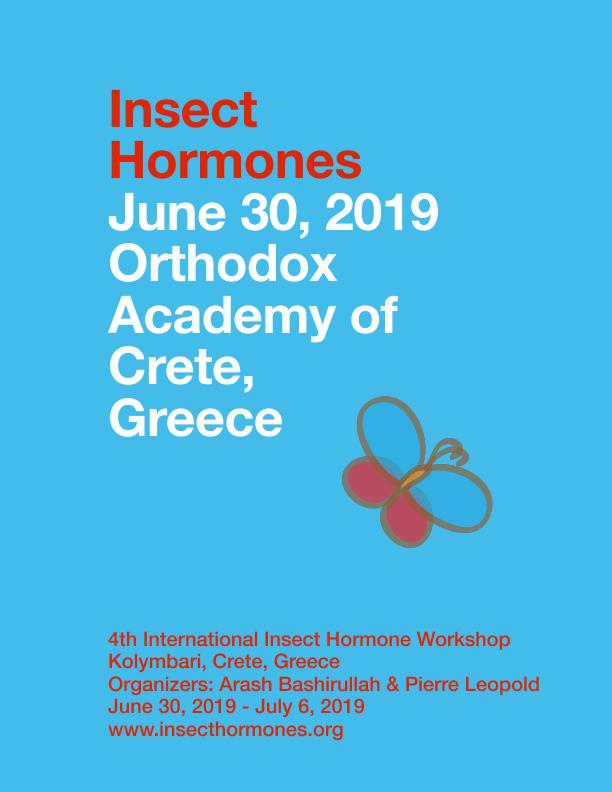Mostrar el registro sencillo del ítem
dc.contributor.author
Garelli, Andres

dc.contributor.author
Heredia, Fabiana
dc.contributor.author
Volonté, Yanel Andrea

dc.contributor.author
Pereirinha, Joana
dc.contributor.author
Casimiro, Andrea
dc.contributor.author
Viegas, Filipe
dc.contributor.author
Belém, Claudia
dc.contributor.author
Tanaka, Kohtaro
dc.contributor.author
Cardoso, Gisela
dc.contributor.author
Macedo, Andre
dc.contributor.author
Leal, Ana
dc.contributor.author
Kotowicz, Malwina
dc.contributor.author
Prado Spalm, Facundo Heber

dc.contributor.author
Mendes, César
dc.contributor.author
Gontijo, Alisson M.
dc.date.available
2023-04-19T17:33:09Z
dc.date.issued
2019
dc.identifier.citation
Progression through pupariation behaviors requires dilp8-Lgr3 signaling between the cuticle epidermis and thoracic CNS neurons; Insect Hormones 2019; Kolymbari; Grecia; 2019; 67-67
dc.identifier.uri
http://hdl.handle.net/11336/194589
dc.description.abstract
Higher dipterans undergo metamorphosis within a puparium, a protective capsule made up of the reshaped and hardened cuticle of the last larval instar. Puparium formation (pupariation) in Drosophila starts when wandering stage larvae reduce their locomotion and initiate increasingly strong whole body contractions that together with the internalization of the three anteriormost body segments remodel the body and cuticle, reducing their length/width ratio from ~5 to ~3. This behavior lasts 5-10 min and culminates with the extrusion of a proteinaceous mix (glue) produced by the salivary glands. The animal then slowly moves forward in a caterpillar-like fashion, traveling about half its length for ~1 min to its final pupariation site. We call this behavior glue-spreading behavior (GSB), as it helps to spread the glue over the ventral part of the animal, promoting its attachment to the underlying substrate. Following GSB, the final shape of the puparium is set, even though weak and periodic contractions occur over the next 40-50 min (post-GSB), the operculum becomes defined, and the cuticle (i.e., the future puparium) starts to gradually sclerotize and tan. Here, we show that proper progression through three pupariation behaviors (pre-GSB, GSB, and postGSB) requires the Dilp8-Lgr3 pathway, a relaxin-like pathway that has been previously implicated in controlling the timing of pupariation in animals carrying aberrantly growing imaginal discs. During pupariation, however, Dilp8-Lgr3 signaling is spatiallyand temporally-distinct: a strong, epidermis-derived dilp8 expression peak that starts at the pre-GSB phase of pupariation appears to signal via Lgr3 in a novel subpopulation of thoracic CNS neurons. While this signaling ensures partial progression through the preGSB phase, and total progression through GSB and post-GSB phases, it is not required for sclerotization and tanning. These results demonstrate a new transient epidermis to neuron signaling event that facilitates progression through the cascade of pupariationassociated behaviors.
dc.format
application/pdf
dc.language.iso
eng
dc.publisher
Insect Hormones
dc.rights
info:eu-repo/semantics/openAccess
dc.rights.uri
https://creativecommons.org/licenses/by-nc-sa/2.5/ar/
dc.subject
DROSOPHILA
dc.subject
DILP8
dc.subject
LGR3
dc.subject.classification
Biología del Desarrollo

dc.subject.classification
Ciencias Biológicas

dc.subject.classification
CIENCIAS NATURALES Y EXACTAS

dc.title
Progression through pupariation behaviors requires dilp8-Lgr3 signaling between the cuticle epidermis and thoracic CNS neurons
dc.type
info:eu-repo/semantics/publishedVersion
dc.type
info:eu-repo/semantics/conferenceObject
dc.type
info:ar-repo/semantics/documento de conferencia
dc.date.updated
2023-02-16T10:14:03Z
dc.journal.pagination
67-67
dc.journal.pais
Grecia

dc.journal.ciudad
Kolymbari
dc.description.fil
Fil: Garelli, Andres. Consejo Nacional de Investigaciones Científicas y Técnicas. Centro Científico Tecnológico Conicet - Bahía Blanca. Instituto de Investigaciones Bioquímicas de Bahía Blanca. Universidad Nacional del Sur. Instituto de Investigaciones Bioquímicas de Bahía Blanca; Argentina. Universidade Nova de Lisboa; Portugal
dc.description.fil
Fil: Heredia, Fabiana. Universidade Nova de Lisboa; Portugal
dc.description.fil
Fil: Volonté, Yanel Andrea. Consejo Nacional de Investigaciones Científicas y Técnicas. Centro Científico Tecnológico Conicet - Bahía Blanca. Instituto de Investigaciones Bioquímicas de Bahía Blanca. Universidad Nacional del Sur. Instituto de Investigaciones Bioquímicas de Bahía Blanca; Argentina. Universidade Nova de Lisboa; Portugal
dc.description.fil
Fil: Pereirinha, Joana. Universidade Nova de Lisboa; Portugal
dc.description.fil
Fil: Casimiro, Andrea. Universidade Nova de Lisboa; Portugal
dc.description.fil
Fil: Viegas, Filipe. Universidade Nova de Lisboa; Portugal
dc.description.fil
Fil: Belém, Claudia. Universidade Nova de Lisboa; Portugal
dc.description.fil
Fil: Tanaka, Kohtaro. Instituto Gulbenkian de Ciências; Portugal
dc.description.fil
Fil: Cardoso, Gisela. Universidade Nova de Lisboa; Portugal. Universidade de Sao Paulo; Brasil
dc.description.fil
Fil: Macedo, Andre. Universidade Nova de Lisboa; Portugal
dc.description.fil
Fil: Leal, Ana. Universidade Nova de Lisboa; Portugal
dc.description.fil
Fil: Kotowicz, Malwina. Universidade Nova de Lisboa; Portugal
dc.description.fil
Fil: Prado Spalm, Facundo Heber. Consejo Nacional de Investigaciones Científicas y Técnicas. Centro Científico Tecnológico Conicet - Bahía Blanca. Instituto de Investigaciones Bioquímicas de Bahía Blanca. Universidad Nacional del Sur. Instituto de Investigaciones Bioquímicas de Bahía Blanca; Argentina
dc.description.fil
Fil: Mendes, César. Universidade Nova de Lisboa; Portugal
dc.description.fil
Fil: Gontijo, Alisson M.. Universidade Nova de Lisboa; Portugal
dc.relation.alternativeid
info:eu-repo/semantics/altIdentifier/url/https://insecthormones.org/crete-2019/
dc.conicet.rol
Autor

dc.conicet.rol
Autor

dc.conicet.rol
Autor

dc.conicet.rol
Autor

dc.conicet.rol
Autor

dc.conicet.rol
Autor

dc.coverage
Internacional
dc.type.subtype
Congreso
dc.description.nombreEvento
Insect Hormones 2019
dc.date.evento
2019-06-30
dc.description.ciudadEvento
Kolymbari
dc.description.paisEvento
Grecia

dc.type.publicacion
Book
dc.description.institucionOrganizadora
Bashirullah, Arash
dc.description.institucionOrganizadora
Leopold, Pierre
dc.source.libro
4th International Insect Hormone Workshop
dc.date.eventoHasta
2019-07-06
dc.type
Congreso
Archivos asociados
